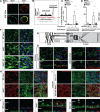Integrin-ECM interactions and membrane-associated Catalase cooperate to promote resilience of the Drosophila intestinal epithelium
- PMID: 35522719
- PMCID: PMC9116668
- DOI: 10.1371/journal.pbio.3001635
Integrin-ECM interactions and membrane-associated Catalase cooperate to promote resilience of the Drosophila intestinal epithelium
Abstract
Balancing cellular demise and survival constitutes a key feature of resilience mechanisms that underlie the control of epithelial tissue damage. These resilience mechanisms often limit the burden of adaptive cellular stress responses to internal or external threats. We recently identified Diedel, a secreted protein/cytokine, as a potent antagonist of apoptosis-induced regulated cell death in the Drosophila intestinal midgut epithelium during aging. Here, we show that Diedel is a ligand for RGD-binding Integrins and is thus required for maintaining midgut epithelial cell attachment to the extracellular matrix (ECM)-derived basement membrane. Exploiting this function of Diedel, we uncovered a resilience mechanism of epithelial tissues, mediated by Integrin-ECM interactions, which shapes cell death spreading through the regulation of cell detachment and thus cell survival. Moreover, we found that resilient epithelial cells, enriched for Diedel-Integrin-ECM interactions, are characterized by membrane association of Catalase, thus preserving extracellular reactive oxygen species (ROS) balance to maintain epithelial integrity. Intracellular Catalase can relocalize to the extracellular membrane to limit cell death spreading and repair Integrin-ECM interactions induced by the amplification of extracellular ROS, which is a critical adaptive stress response. Membrane-associated Catalase, synergized with Integrin-ECM interactions, likely constitutes a resilience mechanism that helps balance cellular demise and survival within epithelial tissues.
Conflict of interest statement
The authors have declared that no competing interests exist.
Figures






Update of
-
A virus-acquired host cytokine controls systemic aging by antagonizing apoptosis.PLoS Biol. 2018 Jul 23;16(7):e2005796. doi: 10.1371/journal.pbio.2005796. eCollection 2018 Jul. PLoS Biol. 2018. Update in: PLoS Biol. 2022 May 6;20(5):e3001635. doi: 10.1371/journal.pbio.3001635. PMID: 30036358 Free PMC article. Updated.
Similar articles
-
Integrin-ECM interactions regulate the changes in cell shape driving the morphogenesis of the Drosophila wing epithelium.J Cell Sci. 2007 Mar 15;120(Pt 6):1061-71. doi: 10.1242/jcs.03404. Epub 2007 Feb 27. J Cell Sci. 2007. PMID: 17327274
-
Redox-relevant aspects of the extracellular matrix and its cellular contacts via integrins.Antioxid Redox Signal. 2014 May 1;20(13):1977-93. doi: 10.1089/ars.2013.5294. Epub 2014 Jan 8. Antioxid Redox Signal. 2014. PMID: 24040997 Free PMC article. Review.
-
Extracellular Matrix Induction of Intracellular Reactive Oxygen Species.Antioxid Redox Signal. 2017 Oct 20;27(12):774-784. doi: 10.1089/ars.2017.7305. Antioxid Redox Signal. 2017. PMID: 28791881 Review.
-
Cell adhesion and motility depend on nanoscale RGD clustering.J Cell Sci. 2000 May;113 ( Pt 10):1677-86. doi: 10.1242/jcs.113.10.1677. J Cell Sci. 2000. PMID: 10769199
-
Cellular growth and survival are mediated by beta 1 integrins in normal human breast epithelium but not in breast carcinoma.J Cell Sci. 1995 May;108 ( Pt 5):1945-57. doi: 10.1242/jcs.108.5.1945. J Cell Sci. 1995. PMID: 7544798
Cited by
-
Perspectives on Scaffold Designs with Roles in Liver Cell Asymmetry and Medical and Industrial Applications by Using a New Type of Specialized 3D Bioprinter.Int J Mol Sci. 2023 Sep 29;24(19):14722. doi: 10.3390/ijms241914722. Int J Mol Sci. 2023. PMID: 37834167 Free PMC article.
-
Chondroitin sulfate regulates proliferation of Drosophila intestinal stem cells.PLoS Genet. 2025 May 9;21(5):e1011686. doi: 10.1371/journal.pgen.1011686. eCollection 2025 May. PLoS Genet. 2025. PMID: 40343906 Free PMC article.
-
The transmembrane protein Syndecan is required for stem cell survival and maintenance of their nuclear properties.PLoS Genet. 2025 Feb 6;21(2):e1011586. doi: 10.1371/journal.pgen.1011586. eCollection 2025 Feb. PLoS Genet. 2025. PMID: 39913561 Free PMC article.
-
Targeting catalase in cancer.Redox Biol. 2024 Nov;77:103404. doi: 10.1016/j.redox.2024.103404. Epub 2024 Oct 19. Redox Biol. 2024. PMID: 39447253 Free PMC article. Review.
References
Publication types
MeSH terms
Substances
LinkOut - more resources
Full Text Sources
Molecular Biology Databases
Research Materials

